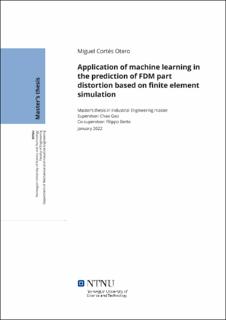| dc.contributor.advisor | Gao, Chao | |
| dc.contributor.author | Cortés Otero, Miguel | |
| dc.date.accessioned | 2022-09-24T17:19:54Z | |
| dc.date.available | 2022-09-24T17:19:54Z | |
| dc.date.issued | 2022 | |
| dc.identifier | no.ntnu:inspera:114172731:93238911 | |
| dc.identifier.uri | https://hdl.handle.net/11250/3021081 | |
| dc.description.abstract | FDM er den mest utbredte teknologien av alle additive produksjonsteknikker i dag. De siste årene har mye blitt fornyet når det gjelder nye materialer for FDM-trykk og prosessforbedringer. Dette har gjort at FDM ikke bare brukes til rask prototyping som før, men funksjonelle strukturer kan produseres ved hjelp av denne produksjonsteknikken. Imidlertid mangler denne trykkteknikken fortsatt dimensjonsnøyaktigh et for spesifikke bruksområder som krever høy nøyaktighet. I dette arbeidet presenteres en tilnærming for hvordan man kan forbedre dimensjonsnøyaktigh eten til FDM-trykte deler. Først lages et numerisk simuleringsrammeverk for additive produksjonsteknikker basert på Abaqus software (v. 2019 Simulia, Dassault Systems). Deformasjonene til tre forskjellige geometrier oppnås ved hjelp av det numeriske simuleringsrammever ket og analyseres. I tillegg utføres en studie av broken av maskinlæringsteknikk er for å forutsi FDM-delforvrengninger. | |
| dc.description.abstract | FDM is the most widespread technology of all the additive manufacturing techniques nowadays. In recent years, much has been innovated in terms of new materials and process improvements for FDM printing. This has meant that FDM is not only used for rapid prototyping as before, but functional structures can be manufactured using this manufacturing technique. However, this printing technique still lacks dimensional accuracy for specific applications that require high accuracy. In this work, an approach of how to improve the dimensional accuracy of FDM printed parts is presented. First, a numerical simulation framework for additive manufacturing techniques is created based on Abaqus software (v. 2019 Simulia, Dassault Systems). The deformations of three different geometries are obtained and analysed using the numerical simulation framework. In addition, a study of the application of machine learning techniques to predict FDM part distortions is carried out. | |
| dc.language | eng | |
| dc.publisher | NTNU | |
| dc.title | Application of machine learning in the prediction of FDM part distortion based on finite element simulation | |
| dc.type | Master thesis | |
